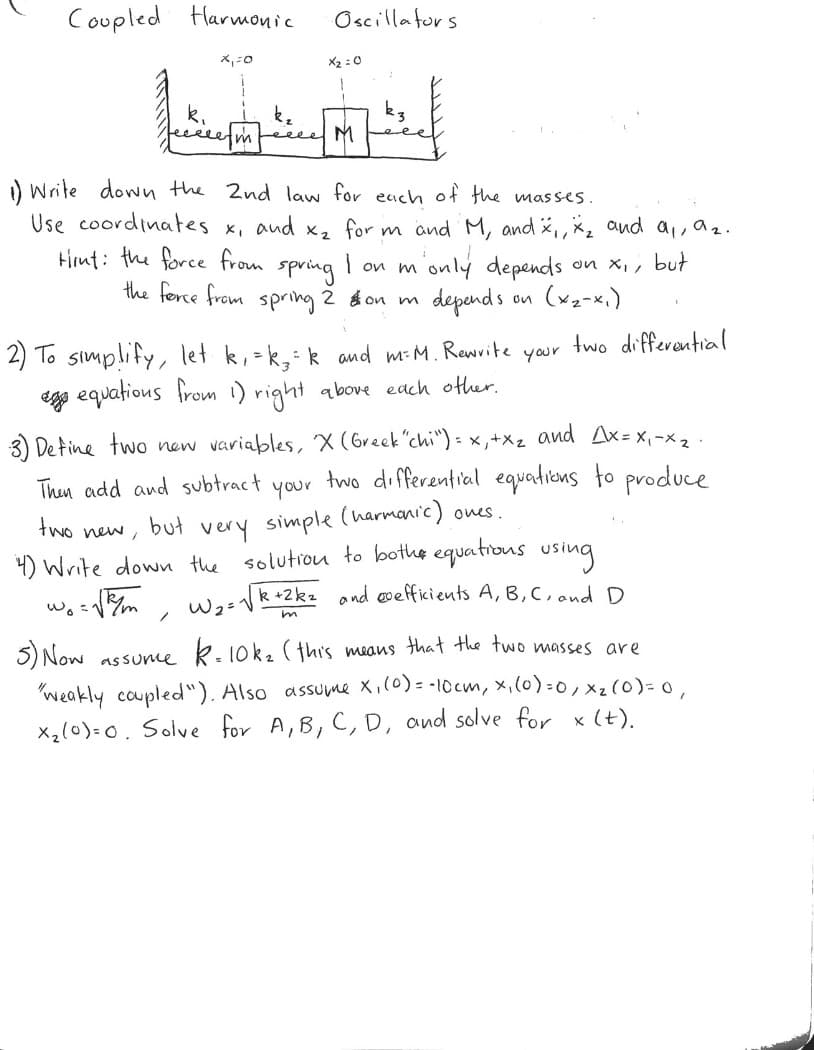Coupled Flarmonic Oscillators X2 : 0 ) Write down the 2nd law for each of the masses. Use coordinates x, aud x, for m and M, and i,, ×2 and a, az. timt: the force from the ferce from spring 2 &on m | on m'only depends but on X,, spring depand s on (x2-x,)
Coupled Flarmonic Oscillators X2 : 0 ) Write down the 2nd law for each of the masses. Use coordinates x, aud x, for m and M, and i,, ×2 and a, az. timt: the force from the ferce from spring 2 &on m | on m'only depends but on X,, spring depand s on (x2-x,)
Classical Dynamics of Particles and Systems
5th Edition
ISBN:9780534408961
Author:Stephen T. Thornton, Jerry B. Marion
Publisher:Stephen T. Thornton, Jerry B. Marion
Chapter8: Central-force Motion
Section: Chapter Questions
Problem 8.7P
Related questions
Question

Transcribed Image Text:Coupled
Harmonic
Oscillators
X2 :0
eeeee
Leeee NM
) Write down the 2nd law for each of the masses.
Use coordinates x, aud x, for m and M, and i,, *2 and a, a2.
Hirnt: the force from spring I on monly depends
on x, , but
the ferce from spring 2 on m
depand s
on (x2-x,)
two differantial
2) To simplify, let k, -k,k and m-M. Rewrite
egg equatious from i) right above each other.
your
3) Detine two new variables, X (Greek"chi") - x,+X2 and Ax = X,-x 2
two di ferential equations to produce
Then add and subtract
your
very simple (harmanic) ones.
4) Write down the solutiou to bothe equations using
Wask+2k2 ond evefficients A, B, C, and D
two new ,
but
w. :
un
5) Now assune k-10k2 (this means that the two masses are
"weakly coupled"). Also assume X,(0) = -10cm, x,(0)=0, xz (0)= o,
x,(0)=0. Solve for A,B, C, D, and solve for x (t).
Expert Solution
Step 1
We will only answer the first question since the exact question to be answered was not specified. Please re-submit a new question specifying the one you'd like answered.
Step 2 (1)

Given, masses m and M. Where, M>m.
And, are the respective displacements of m and M from its equilibrium position.
We deduce,
So, writing Newton's second law of motion for both the masses.
For mass m:
For mass M:
Step by step
Solved in 3 steps with 1 images

Knowledge Booster
Learn more about
Need a deep-dive on the concept behind this application? Look no further. Learn more about this topic, physics and related others by exploring similar questions and additional content below.Recommended textbooks for you

Classical Dynamics of Particles and Systems
Physics
ISBN:
9780534408961
Author:
Stephen T. Thornton, Jerry B. Marion
Publisher:
Cengage Learning

University Physics Volume 3
Physics
ISBN:
9781938168185
Author:
William Moebs, Jeff Sanny
Publisher:
OpenStax

Classical Dynamics of Particles and Systems
Physics
ISBN:
9780534408961
Author:
Stephen T. Thornton, Jerry B. Marion
Publisher:
Cengage Learning

University Physics Volume 3
Physics
ISBN:
9781938168185
Author:
William Moebs, Jeff Sanny
Publisher:
OpenStax